We explore the life of Joan of Arc and her military achievements. In addition, we discuss her characteristics and tragic death.
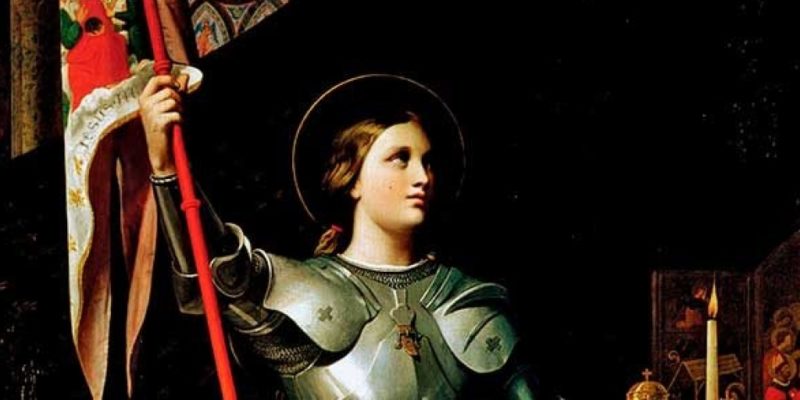
Who was Joan of Arc?
Joan of Arc (in French, Jeanne d'Arc), also known as the Maid of Orléans or Saint Joan of Arc among Catholics, was a medieval Christian peasant girl who became a national heroine of France. She led troops of the French army against the English and Burgundians in decisive battles of the Hundred Years' War. With her help, Charles VII of Valois was crowned King of France.
Her story is widely renowned since, despite being a woman and a peasant at a time when warfare was typically conducted by noblemen, she came to lead important troops of the French army at only 17 years of age. She claimed to be guided by the voices and visions of angels and saints. Over the years, various explanations have been proposed for these visions, ranging from schizophrenia and cunning to genuine religious belief. At the age of 19, she was burned at the stake on charges of heresy.
Today, Joan of Arc is regarded as a national heroine of France, a Christian martyr, or an emblem of the emancipation of women from conventional social roles. Her image was used as a symbol of national unity and as an inspiration for French troops during military events such as the Franco-Prussian War and the First and Second World Wars. Her life has been portrayed in numerous theatrical, literary, and film works.
- See also: Alexander the Great
Birth and childhood of Joan of Arc
Joan of Arc was born in the village of Domrémy, in northeastern France, which now bears the name Domrémy-la-Pucelle in her honor ("la Pucelle", often translated as "the Maid", was the nickname given to Joan in reference to her youth).
The exact date of her birth is unknown, as there was no birth and baptism record for peasants like those in Domrémy at the time. However, at the first session of her interrogation by an ecclesiastical court on February 21, 1431, she claimed to be "about nineteen years old", suggesting she would have been born in 1412.
Her birth name and the name she employed to sign the letters she dictated (since she was illiterate) was Jehanne, which was how Jeanne was spelled in French at the time. In her home village, she was allegedly known as Jeannette (something equivalent to "Janet" in English).
She was the daughter of a farmer named Jacques Darc, who owned land and held public offices in Domrémy but was not of noble birth (he was ennobled along with his family by King Charles VII in 1429). Her last name appears in historical sources written in different ways (for example, Darc, d'Arc, Tarc), but the one by which Joan became known was d’Arc (anglicized as "of Arc"). Its origin is a subject of debate: while some scholars suggest it makes reference to the nearby village of Arc-en-Barrois, it remains an area of contention.
Jeanne's mother was Isabelle Romée, whose birth name would have been Isabelle de Vouthon, and who married Jacques at the time they settled in Domrémy.
From what comes down to us, Joan was the fourth of five siblings (three elder brothers and a younger sister, of whom clear records do not exist). While Joan had to take care of domestic and peasant duties, her family was not economically deprived thanks to her father's social standing in the village.
The Hundred Years' War
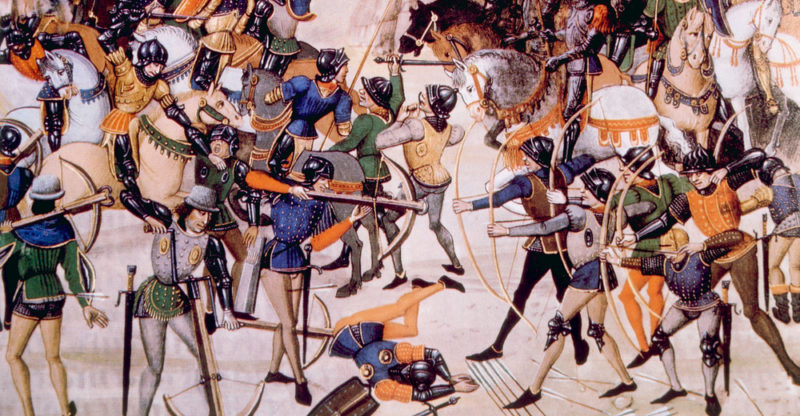
The rivalry between France and England can be traced back to at least 1066, when William the Conqueror, Duke of Normandy, claimed the English throne after emerging victorious at the Battle of Hastings.
From then on, the Norman dukes, who were vassals of the King of France on the continent, came to have greater power than the latter, especially when Henry Plantagenet (Duke of Normandy from 1150) also became Count of Anjou in 1151, Duke of Aquitaine in 1152 (through marriage to Eleanor, recently divorced from King Louis VII of France) and King of England in 1154. Thus, the King of England held sway over a large part of the French territory, leading to conflicts in the ensuing years.
The Hundred Years' War broke out at a time when the King of France had regained authority over most of the territory and confiscated in 1337 the Duchy of Guyenne still held by the English. Moreover, there was a succession dispute, as upon the death of heirless King Charles IV of France in 1328, the French throne was claimed by both Count Philippe de Valois, nephew of Philip IV of France, and King Edward III of England, son of Isabella (sister of Charles IV).
During Joan of Arc's lifetime, the English had emerged victorious in battles like Agincourt (1415), and had allied with the Burgundians of France, who supported the English King's claim to the French throne (Henry VI from 1422). The English and Burgundians dominated the southwest and north of France, including Paris. The Dauphin, Charles, heir to the throne of France by right of primogeniture, controlled most of central and southern France with the support of the Armagnacs, rivals to the Burgundians, but his position became increasingly endangered. It was Joan of Arc's intervention in 1429 that tipped the balance in his favor.
The war ended in 1453 with the English withdrawal from France (except Calais). Though it spanned 116 years, actual warfare was intermittent. Still, the conflict left much of the French territory devastated, significantly weakening the feudal nobility.
Divine inspiration
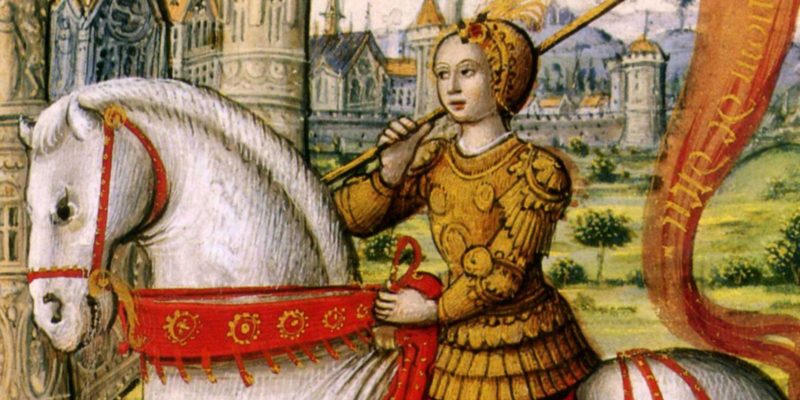
At her trial before an ecclesiastical court, Joan of Arc testified that she had heard the voice of God for the first time at the age of thirteen, in her father's garden. According to her testimony, this voice came from the side of the church and was accompanied by a powerful light. Although initially overcome with fear, Joan later realized it was an angel sent by God.
In her statement, she said that the voice belonged to the archangel Michael, and that he later appeared to her in such a manner that she could see him with her own eyes. She also identified the voices and visions of two other Catholic saints: Saint Catherine of Alexandria and Saint Margaret of Antioch, highly venerated by Catholicism at the time. According to her account, the voices and visions repeated throughout three years. Initially, they urged her to lead a pious life, and then spurred her to go into France, lift the siege of Orléans (which had begun in October 1428), and ensure the Dauphin Charles, was crowned king.
There have been various explanations to account for the voices and visions Joan of Arc heard and saw: from a medical condition (such as schizophrenia) or cunning to persuade a large number of people, to a sincere belief rooted in a particular way to interpret the world or, for some Christians, true divine inspiration.
In any case, one experience that seems to have influenced Joan's decision to meet with the Dauphin, Charles, whether or not she believed she had been summoned by God, was the military raid led by a Burgundian ruler against the town of Vaucouleurs in 1428.
At the time, Domrémy was located on the border between France and the Holy Roman Empire. Its inhabitants were allegedly loyal to the Armagnacs, who defended the right of the Dauphin Charles to the French throne, thus opposing the Burgundians who, aligned with the English, dominated most of the region.
The town of Vaucouleurs, also loyal to Charles, was able to resist the attack, but the onslaught affected nearby villages that were burned, including Domrémy. Joan and her family managed to flee, but this event seems to have prompted her interview with Captain Robert de Braudicourt in Vaucouleurs and her determination to travel to Chinon to meet Charles and fight against the English.
Siege of Orléans
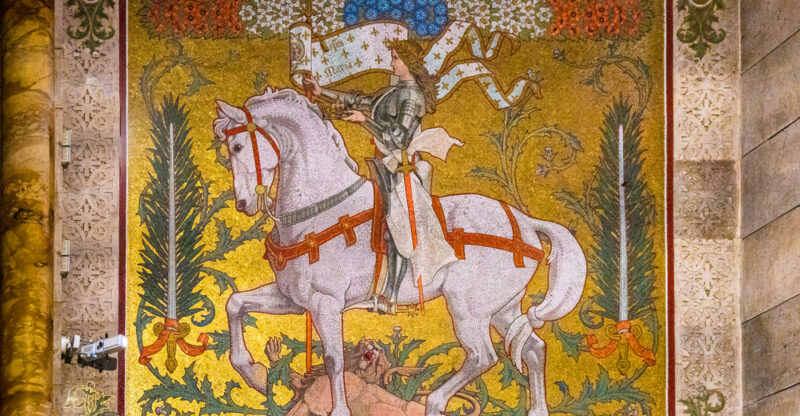
Orléans was a city of strategic significance. Some believed that if it fell into the hands of the English, the French loyal to the Dauphin Charles would definitely be defeated. The English siege of the city began in October 1428. Joan later declared that the voices of the archangel Michael and Saints Catherine and Margaret persuaded her to help Charles lift the siege.
To achieve this, she went to Robert de Baudricourt, captain of a French garrison in Vaucouleurs, and requested a small escort to travel to the castle of Chinon. Her goal was to meet the Dauphin and convince him that divine voices had sent her to help him raise the siege of Orléans.
At that time, prophecies circulated about a maiden or virgin who would save the French kingdom. Possibly due to these popular beliefs and her persistence, Joan achieved her goal: dressed as a man and accompanied by an escort, she crossed hostile territory on horseback and arrived in Chinon at the end of February 1429.
According to testimonies, Charles met Joan, during which meeting she conveyed her desire to confront the English militarily. She also told him that the voices had assured her he would be crowned king in Reims (the city where French kings were traditionally consecrated, but which was then under Burgundian control). After theologians and other religious figures had examined her to ensure she was a good Christian, the Dauphin decided to trust her.
This decision may have arisen from the desperate situation in which Orléans found itself after months of siege, which justified the use of an inspiring figure to boost French morale. Thus, Charles placed her at the head of an army, wearing armor, sword and a banner bearing the names Jesus and Mary.
With her troops and supplies for the besieged, she reached the outskirts of Orléans and managed to enter the city. In the following days, assaults on the surrounding English fortresses ensued until, on the ninth day, the English withdrew.
The role Joan played in the defense of Orléans remains a subject of debate among historians. Some argue her presence was pivotal, either due to her bravery with the troops or the effect of her figure on the defenders' morale. Others suggest that the victory was the result of a tactical change unrelated to Joan's decisions, which yet allowed her to be perceived as the heroine of the prophecies.
What seems certain is that she played an active role in inspiring the city’s defenders, and that she participated in some attacks against the English positions waving her banner, being wounded in the shoulder by an arrow. For this reason, she is often referred to as "the Maid of Orléans".
Loire campaign
Following the successful defense of Orléans, the French troops serving the Dauphin Charles went on the offensive. Joan of Arc actively participated in this campaign, with some historians actually holding that it was carried out under her initiative, due to her conviction that they must advance to Reims for Charles’ coronation. In any case, there is evidence that other advisors and commanders also participated in its planning and execution.
The Loire campaign of June 1429 consisted of the successive capture of three towns in the Loire valley (Jargeau, Meung-sur-Loire, and Beaugency) located near strategically important bridges controlled by the English, and the victory at the battle of Patay.
This series of military successes paved the way for the French advance to the north. Joan of Arc was at the head of some of these troops alongside Duke John II of Alençon, whom she referred to as "the gentle duke", though in Patay her troops arrived after the cavalry and infantry under other commanders, like La Hire and Jean Poton de Xaintrailles, had already achieved victory.
With the triumph of this campaign, the path was cleared to continue with Joan’s plan (which she attributed to divine inspiration), that is, to advance with Charles to Reims, in the north, and have him crowned king at the cathedral.
Coronation of Charles VII
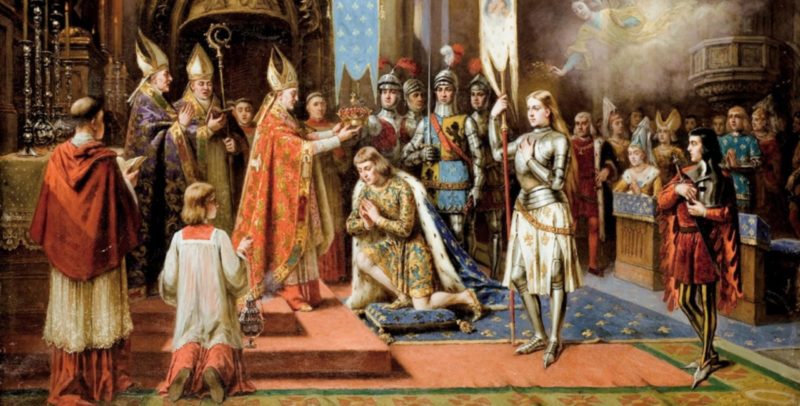
Among the missions that, according to Joan of Arc, had been entrusted to her by God, was the task of accompanying the Dauphin to Reims, where he was to be crowned the rightful King of France. The undertaking was perilous, since it involved advancing into territory controlled by the Burgundians and the English. Nonetheless, Joan was adamant about the urgency of crowning Charles at Reims Cathedral, the traditional site for the consecration of the French monarchs, so that his divine-sanctioned legitimacy would be ensured.
Thanks to the resounding victory in Orléans and the Loire valley, and possibly also to Joan's reputation, the towns through which Charles' army passed either capitulated or showed loyalty to the Dauphin, including the city of Troyes, which initially resisted but eventually surrendered.
Thus it was that the troops arrived at Reims, where the inhabitants opened the gates. On July 17, 1429, the Dauphin was crowned King of France as Charles VII, with Joan of Arc at his side during the ceremony, marking the pinnacle of her exploits.
Capture at Compiègne
Following his coronation in Reims, Charles VII negotiated a two-week truce with the Burgundians, which they used to reinforce the defense of Paris, facing an imminent attack. The control of the capital held political significance, and its capture by Charles VII would have meant a hard blow for the Burgundians and would have definitely tipped the balance in favor of the Armagnacs loyal to Charles. However, the assault on the city on September 8 was an absolute disaster, with Charles VII's troops retreating after suffering over a thousand casualties and Joan being injured by an arrow in her thigh.
In the months that ensued, Joan led several attacks on fortified locations and was ennobled by the king, alongside her family, in recognition of her military exploits.
In May 1430, she led a company to relieve the city of Compiègne, which was under siege by a Burgundian army. On May 23, her troop was ambushed and Joan was captured. Subsequently, the Burgundians handed her over to the English in exchange for a sum of money.
Trial and execution of Joan of Arc
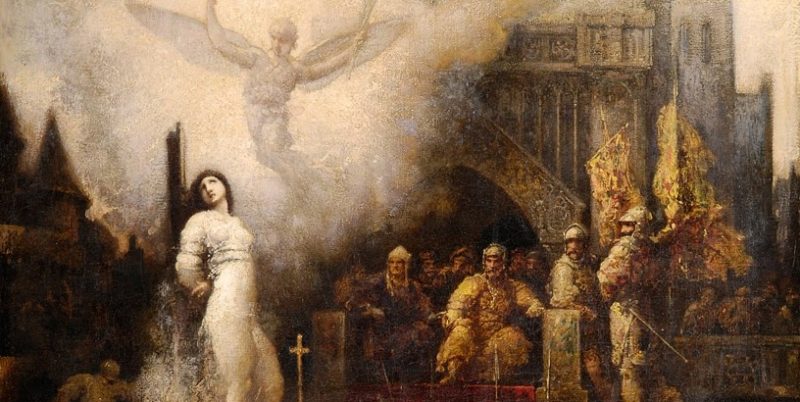
When the Burgundians handed Joan of Arc over to the English, the latter imprisoned her in Rouen Castle, where they had their seat of government in France. She remained there from December 23, 1430, until her execution on May 30, 1431.
Joan was accused of heresy and was examined by an ecclesiastical court presided over by Bishop Pierre Cauchon of Beauvais, who belonged to the Burgundian faction, enemies of King Charles VII. Despite the ecclesiastical nature of the trial, Joan remained locked in a secular cell, in one of the towers of Rouen castle, where she had to endure frequent harassment.
Throughout the trial, she was subjected to rigorous interrogations involving nearly 120 accusers and witnesses. She was accused of witchcraft, wearing male clothes, and other charges aimed at proving that behind her apparent Catholic piety, a heretic was concealed. Whether or not they believed in all the accusations against her, the political expediency of discrediting a figure who had given renewed inspiration to the French loyal to Charles VII was evident.
The trial took place between January and May 1431. Much of what we know about Joan of Arc's life, religious beliefs, and tragic end comes down to us from the records of this trial. Although throughout the interrogations she maintained her assertions regarding the messages she claimed to have received from God to crown Charles VII and drive the English out of France, in one of the last sessions she recanted, denying the visions of the archangel Michael and Saints Catherine and Margaret. However, a few days later she withdrew her recantation, arguing that she had only pronounced it out of fear of being burned, and adding that the saints had communicated with her to admonish her for not speaking the truth.
Finally, Joan of Arc was found guilty of more than seventy charges, including inventing false revelations and divine visions, dressing as a man, committing blasphemy, and being suspected of heresy. Having retracted her initial recantation, she became a "relapsed heretic" to the court’s eyes.
She was sentenced to burn at the stake. Handed over to the English secular authority, her execution took place in Rouen's Old Market square on May 30, 1431, when she was 19 years old. Her ashes were thrown into the Seine River. Twenty years later, Joan's mother initiated a trial review process, by which the sentence was eventually annulled due to procedural flaws. It was 1456, the Hundred Years' War had ended, and the English had withdrawn from France.
From then on, Joan’s figure gained prominence as a French national symbol, particularly from the 19th century onward, and she has been depicted in literary, theatrical, pictorial, and film works. In 1920, she was canonized by Pope Benedict XV.
Quotes by Joan of Arc
- "In God’s name let us go on bravely".
- "I do not know of having committed mortal sin. If I were in mortal sin, I think St. Catherine and St. Margaret would at once abandon me".
- "The soldiers will fight and God will grant victory".
- "I would rather die than do something which I know to be a sin".
- "Courage! Do not fall back; in a little the place will be yours".
- "I fear nothing for God is with me".
References
- Jeanne d’Arc la Pucelle. https://www.jeanne-darc.info/
- Pernoud, R. & Clin, M. V. (2011). Jeanne d’Arc. Fayard-Pluriel.
- Vale, M. G. A. & Lanhers, Y. (2022). St. Joan of Arc. Encyclopedia Britannica. https://www.britannica.com/
- Wood, C. T. (1991). Joan of Arc & Richard III. Oxford University Press.
Explore next:
Was this information useful to you?
Yes NoThank you for visiting us :)